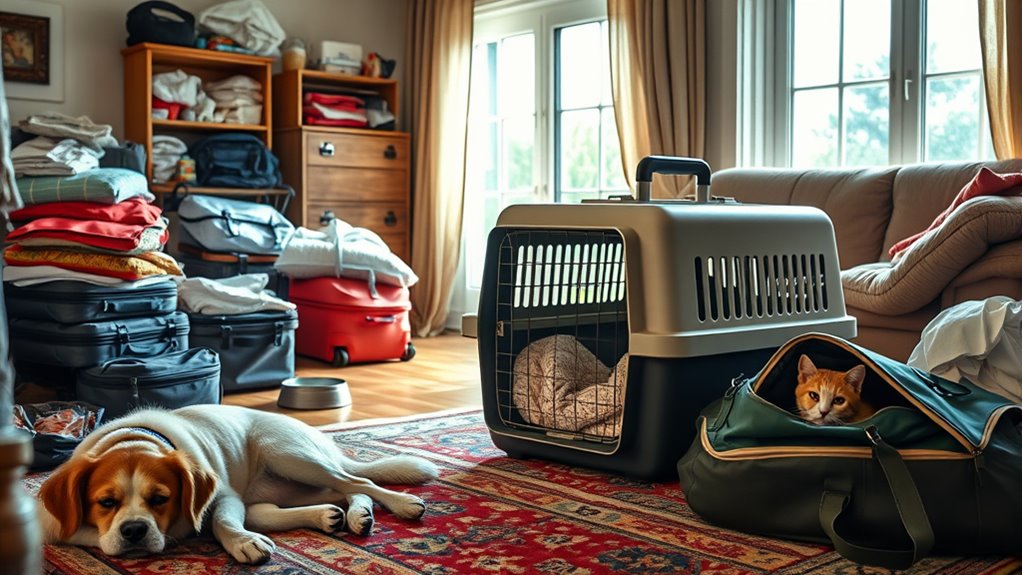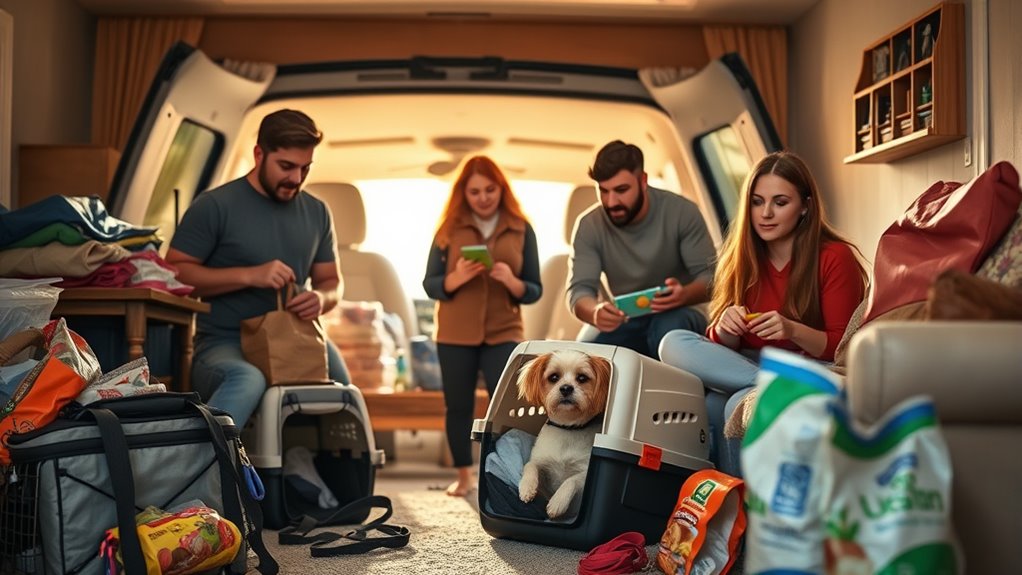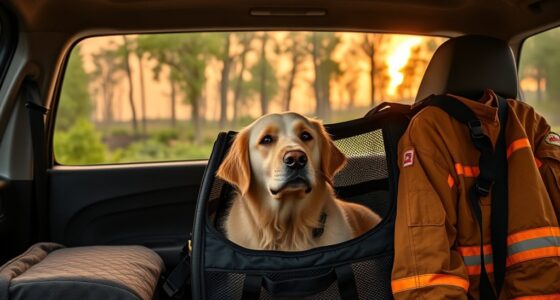When moving with pets during emergencies, prepare an easily accessible emergency kit with food, water, medications, and familiar items. Update identification tags and consider microchipping for extra security. Practice securing pets in carriers or harnesses and familiarize them with these safety tools to reduce stress. Know your evacuation routes and find pet-friendly shelters. Having a clear plan and supplies ready makes the process smoother—continue exploring for detailed tips to guarantee your pets’ safety.
Key Takeaways
- Prepare an emergency kit with food, water, medications, and familiar items for your pet’s comfort and safety.
- Update ID tags, microchip information, and carry current vaccination and medical records.
- Practice securing your pet with carriers or harnesses and rehearse evacuation routes regularly.
- Know the location of pet-friendly shelters or hotels along your planned route.
- Keep emergency supplies and documentation easily accessible for quick response during crises.

When emergencies strike, moving your pets safely becomes a top priority. You need to have a clear plan to ensure their well-being throughout the chaos. Pet safety during a crisis hinges on effective emergency planning, which means preparing in advance to minimize stress and confusion. The first step is to gather all essential supplies in one easily accessible kit. Include food, water, medications, and familiar items like toys or blankets that can provide comfort. Don’t forget to pack leashes, harnesses, and carriers suitable for each pet, so you can quickly secure them when needed. Practice using these items beforehand so you’re comfortable with handling your pets calmly during a stressful situation.
Creating a detailed emergency plan is crucial. Know your evacuation routes and identify pet-friendly shelters or hotels along the way. Keep a printed list of emergency contacts, including your veterinarian and local animal rescue organizations, stored in your pet’s kit. When planning, consider your pet’s specific needs—such as mobility issues or medical conditions—and incorporate solutions into your plan. For example, if your pet is anxious or easily frightened, carry calming aids or consult your vet for recommendations. Make sure your pets are current on vaccinations and have proper identification, like collars with updated tags and microchips. This can help reunite you if you get separated. Being aware of dream recall techniques can also improve your ability to remember important details about your emergency plan, should you need to review it in a stressful situation.
Practicing your emergency plan enhances pet safety by reducing panic and confusion. Conduct drills that involve quickly packing supplies, securing your pets, and navigating your evacuation route. This preparation helps everyone stay calmer under pressure. During an actual emergency, quick decision-making is vital. Keep your pet’s emergency kit in an accessible location, so you don’t waste precious time searching for supplies. Always prioritize their safety by securing them in carriers or harnesses before leaving the house. Never leave a pet behind or unrestrained in unfamiliar environments, as this can lead to injuries or separation.
Finally, stay informed about the situation through reliable news sources and alerts. Communicate with local authorities and follow their guidance on evacuations. Remember, your preparedness directly impacts your pet’s safety. Regularly reviewing and updating your emergency plan ensures you’re ready to act swiftly and confidently when disaster strikes. By investing time in planning and practicing, you’ll be better equipped to protect your pets and keep them safe during unpredictable emergencies.
Frequently Asked Questions
How Can I Ensure My Pet Stays Calm During Emergency Travel?
To keep your pet calm during emergency travel, recognize signs of pet anxiety and use calming techniques. Talk softly, provide familiar blankets or toys, and maintain a steady, reassuring voice. Use pheromone sprays or calming wraps if needed. Keep the environment secure and comfortable, minimizing noise and sudden movements. Your calm demeanor helps your pet feel safe, reducing their stress and making travel less traumatic.
What Are the Best Transportation Options for Different Types of Pets?
Did you know that over 60% of pet owners prefer vehicle travel for emergencies? For different pets, choosing the right transportation matters. Use pet carriers for cats and small animals to guarantee safety, and secure them in the vehicle for stability. For larger pets, consider a well-ventilated crate or harnesses that keep them safe during sudden stops. Prioritize vehicle safety to make your pet’s emergency travel as secure as possible.
How Should I Handle Pets With Special Medical Needs During Relocation?
When relocating with pets with special medical needs, you should prepare by packing all pet medications and copies of veterinary records. Consult your vet beforehand for advice and any necessary prescriptions. Keep medications in a portable, accessible container during transit. Guarantee your pet’s medical needs are prioritized, and stay calm to reduce stress. Regularly check on your pet’s condition and have emergency contacts ready in case of unexpected issues.
What Documents Are Necessary for Moving Pets Across State or Country Borders?
You need to gather essential pet travel documentation, including vaccination records, health certificates, and proof of microchipping, to comply with international pet regulations and guarantee smooth border crossings. Check specific requirements for your destination, as some countries have strict quarantine rules or additional permits. Always verify the latest international pet regulations well in advance, and carry both original documents and copies to avoid delays or refusals during your move.
How Can I Prepare My Pet for Sudden Emergency Evacuations?
Your pet’s safety is your top priority, especially during sudden emergencies. To prepare, keep emergency supplies like water, food, and a familiar blanket ready at all times—think of it as your pet’s superhero toolkit. Make sure they’re microchipped and have updated ID tags. Practice quick evacuations, so your furry friend stays calm and safe. These steps turn chaos into manageable moments, protecting your pet from the storm ahead.
Conclusion
When emergencies strike, think of your pet as a brave sailor steering stormy seas—you’re their steady lighthouse guiding them safely home. With careful planning and a calm mind, you can turn chaos into a smooth voyage. Your love is the compass that keeps everyone on course, transforming a stressful situation into a journey of hope and safety. Remember, your preparedness is the anchor that keeps your furry friend’s heart anchored in security.










